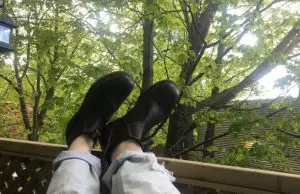Can You Hike In Cowboy Boots? (Answered)

Thinking of taking your cowboy boots out on a hike with you? There are some things you should know before you hit that dusty trail.
A cowboy boot is one of the most iconic shoes in the world, and with its tall cowhide make, plenty of hikers are eager to take them out for a hike, but is that a good idea?
Quick Links
What Were Cowboy Boots Made For?
A cowboy boot, known today as a fashionable article of clothing, is inherently utilitarian in its design. The cowboy boot that we know today is a riding boot that was created specifically for mounting and dismounting a Western riding saddle. The smooth, gripless sole that the early cowboy boot donned allowed for effortless insertion into the stirrup of the traditional Western saddle.
The earliest cowboy boots had a rounded or squared-off toe, which was the most comfortable shape for the foot. It wouldn’t be until the 1940s, with Hollywood’s boom of Western movies, that the very narrow, stylized toe began to show up in the design of a cowboy boot. Although far less comfortable than the original design, the pointed toe made it easier for a cowboy to slip their foot into their stirrups. This stylized pointed toe would be the prevailing design for a cowboy boot for decades to come.
Although there’s no true date or year that can accurately pinpoint just when the traditional cowboy boot came to be, the origins of the classic footwear can date back to as early as the 16th century. When the Spanish had begun colonizing the Americas, they had brought along with them a traditional method of herding their animals. This tradition ultimately influenced the indigenous communities of Northern Mexico, which in turn yielded the Vaquero herding tradition, which most closely resembles cowboy culture as we know it today.
Cowboy boots are known to be especially long-lasting, which may insinuate to a novice hiking enthusiast that they might be durable enough to take out on a 10-mile rocky trail, but this couldn’t be further from the truth.
Is It a Good Idea to Hike in Cowboy Boots?
The short answer to this burning question is a hard no, and here’s why:
Lack of Traction
One of your main priorities should be grip and traction when deciding on an appropriate shoe to take with you out on the trails. Although made for the outdoors, cowboy boots often have little to no traction, making traversing certain terrain difficult and sometimes dangerous. Some cowboy boots are made with a textured sole; however, these boots still often come up short in the traction they offer compared to a proper hiking boot.
Way Too Heavy
Did you know that your shoe’s weight can directly impact your hike’s quality? Many studies have shown that carrying an extra 3 pounds on your foot is the equivalent of carrying 25 pounds on your back. With that in mind, the average weight of a traditional cowboy boot is about 4-5 pounds. Compare that to a pair of ultralight trail runners that come in at just 1 pound, and it’s pretty clear which shoe would be the most practical to take on the trails.
Unbreathable Material
Cowboy boots are traditionally made from the skin of an animal. Most often, they are made from the hide of a cow, snake, lizard, as well as a variety of other exotic animals. While this can make for boots of a very high caliber and quality, leather is a notoriously unbreathable material. So unless you’re planning to hike in the winter, where more insulation is necessary, you will want to opt for a boot with a more breathable material.
If you wear cowboy boots out on your hike, you’re putting yourself at a higher risk of developing blisters and potentially even a fungal infection from all the sweat you’ll surely be producing.
Impractical Heel
Although stylish, the heel that most cowboy boots have is going to get in the way more often than not. If your hike involves traversing over rough terrain, it’s likely that your heel is gonna contribute to a few trips and falls if you’re not careful. The rigid heel of a cowboy boot can also make it rather dangerous to walk across damp surfaces such as slippery rocks or mud.
While some hiking boots do come with a heel, this design comes in handy when trekking up steep hills. A proper hiking boot’s sole will always ensure minimal trips and falls.
Little to No Padding
Padding in your shoe ensures that your feet are as comfortable and blister-free as you take longer hikes. A cowboy boot often offers very little padding, which can make walking distances over 5 miles unbearably uncomfortable. If you ever find yourself doing this, you’ll also find yourself with a gang of blisters to commemorate this hiking faux pas.
How to Walk Comfortably in Cowboy Boots
Even though it’s not the best idea to hike in cowboy boots, relaying some information on how to comfortably walk in your cowboy boots will be valuable to those still looking to get a pair.
Similar to a hiking boot, cowboy boots require a period of breaking in. When you first buy your cowboy boots, they’re going to be a bit stiff, so a good deal of patience, walking, and maybe a couple of blisters are required to get your boot fitting as comfortably as possible.
In addition, a few other steps are needed to ensure your cowboy boots are comfortable enough for frequent or occasional use.
Get Properly Sized
As with any shoe, it’s a great idea to make sure that your cowboy boot is fitted adequately to your foot to guarantee the highest level of comfort. Unlike a hiking boot that needs space in the toes to ensure comfort, a cowboy boot needs space in its heel, with the toes fitting snugly to ensure maximum comfort.
Choosing a cowboy boot of the wrong size can significantly affect your ability to walk and has the potential to irreversibly damage this often expensive purchase.
Stretch Your Boots
If you do find yourself with a cowboy boot that’s a little too tight, there is some hope! There are several ways in which you can attempt to stretch your boots out, with the most common method being a boot stretcher.
To speed up the process, you can opt to use liquids such as a boot stretching spray, water, or rubbing alcohol. Boot stretching spray is going to be your safest bet in helping stretch out your boots because it’s made with ingredients that are especially kind to expensive leather.
Soaking your cowboy boots in water is a viable alternative; however, be sure not to soak them for too long. Otherwise, you risk discoloring the leather and causing them to shrink, the exact opposite of the desired effect.
Using rubbing alcohol to stretch your cowboy boot is going to be the riskiest option out of the three. Using rubbing alcohol can significantly damage the leather and cause them to become misshapen over time.
Shift Your Weight to The Heel
This might be a bit uncomfortable at first, but shifting your weight to the heel of your cowboy boot is going to help you avoid trips and falls. This will also help prevent blisters as you break in your boot, as keeping the weight on the balls of your feet could prove to be uncomfortable when wearing a brand new pair of cowboy boots.
Conclusion
A cowboy boot is an excellent outdoor shoe. However, it’s far from the best footwear to take with you out on a hike.
Remember, when you’re hiking, your foundation is everything. The shoes you decide to wear out on the trail have the potential to make or break your experience, so always choose your pair wisely and intelligently.






